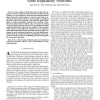Free Online Productivity Tools
i2Speak
i2Symbol
i2OCR
iTex2Img
iWeb2Print
iWeb2Shot
i2Type
iPdf2Split
iPdf2Merge
i2Bopomofo
i2Arabic
i2Style
i2Image
i2PDF
iLatex2Rtf
Sci2ools
TIT
2010
2010
Periodic orbits and equilibria in glass models for gene regulatory networks
Abstract--Glass models are frequently used to model gene regulatory networks. A distinct feature of the Glass model is that its dynamics can be formalized as paths through multi-dimensional binary hypercubes. In this paper, we report a broad range of results about Glass models that have been obtained by computing the binary codes that correspond to the hypercube paths. Specifically, we propose algorithmic methods for the synthesis of specific Glass networks based on these codes. In contrast to existing work, bi-periodic networks and networks possessing both stable equilibria and periodic trajectories are considered. The robustness of the attractor is also addressed, which gives rise to hypercube paths with nondominated nodes and double coils. These paths correspond to novel combinatorial problems, for which initial experimental results are presented. Finally, a classification of Glass networks with respect to their corresponding gene interaction graphs for three genes is presented.
Education | Glass Models | Glass Networks | Hypercube | TIT 2010 |
| Added | 22 May 2011 |
| Updated | 22 May 2011 |
| Type | Journal |
| Year | 2010 |
| Where | TIT |
| Authors | Igor Zinovik, Yury Chebiryak, Daniel Kroening |
Comments (0)

